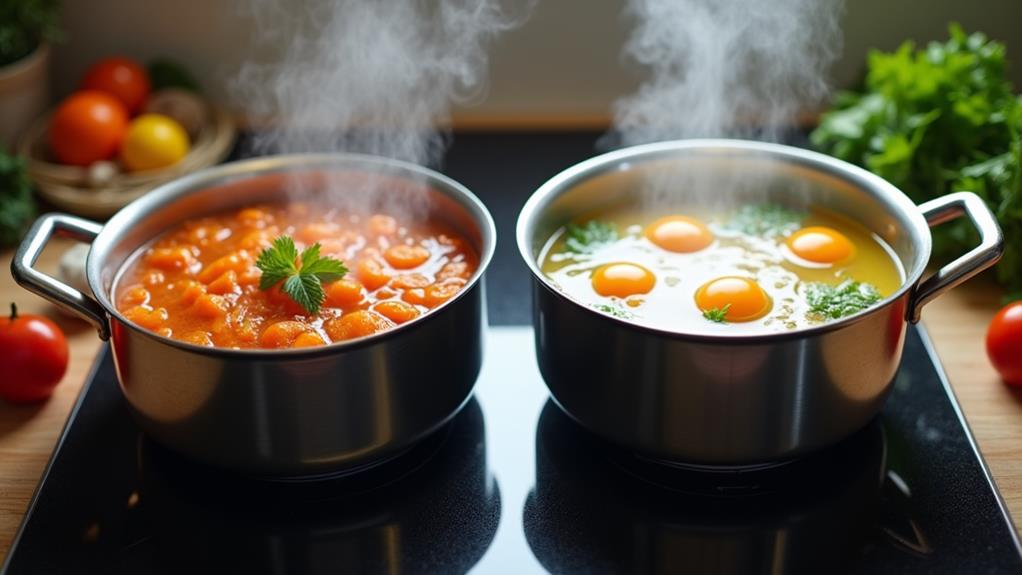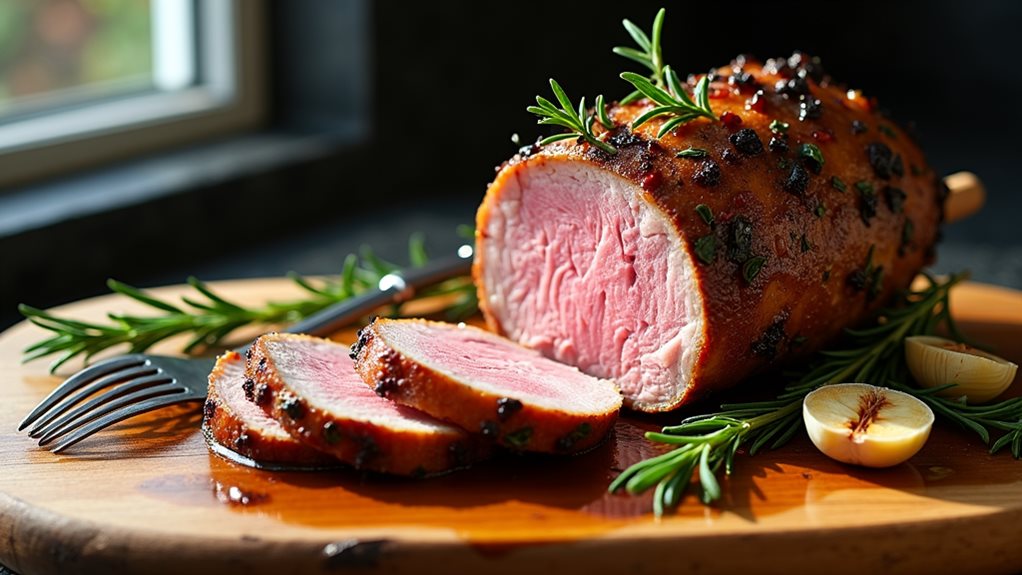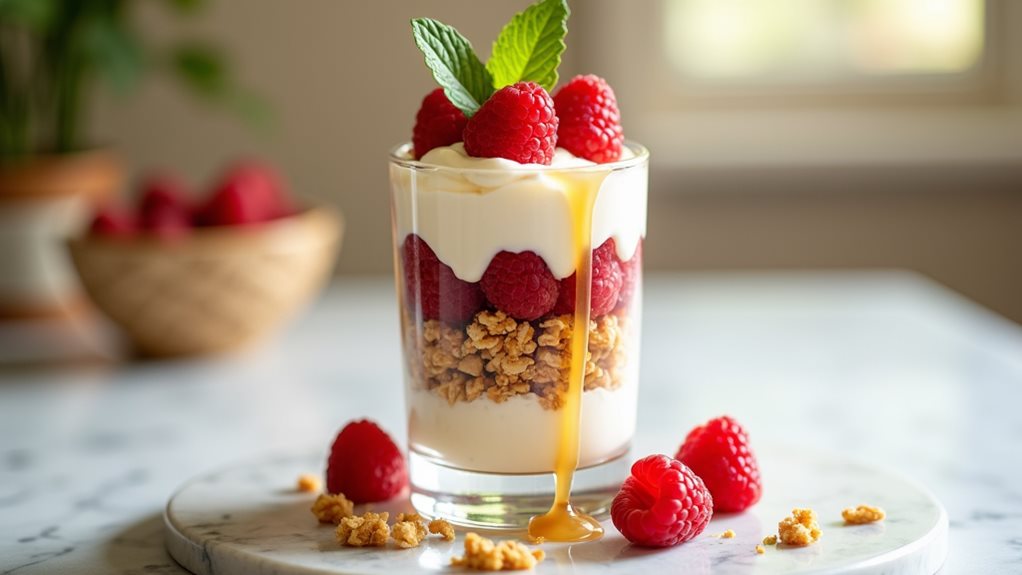When comparing boiling and poaching, you'll find distinct health impacts. Boiling, at 212°F (100°C), efficiently cooks hearty foods but can lead to nutrient loss. Poaching, using lower temperatures of 160-180°F (71-82°C), preserves more nutrients and delicate textures. Both methods offer low-fat cooking options, but poaching excels in retaining vitamins and minerals, especially in fragile ingredients like fish and eggs. Boiling's higher heat kills more bacteria, enhancing food safety, while poaching's gentler approach maintains protein structures. Your choice depends on the food type and desired outcome. Consider texture, nutrient retention, and flavor profiles to determine which method best suits your health goals and culinary preferences.
Defining Boiling and Poaching
Boiling and poaching are two distinct cooking methods that use water as the primary medium.
When you're boiling food, you're submerging it in water that's reached its boiling point of 212°F (100°C). This aggressive technique involves large, rolling bubbles and is ideal for foods that can withstand high heat, like pasta or vegetables. Boiling techniques often require a rapid boil, where you'll see vigorous bubble activity and steam rising from the pot.
On the other hand, poaching is a gentler approach. You'll simmer food in liquid that's just below the boiling point, typically between 160°F and 180°F (71°C to 82°C).
Poaching methods are perfect for delicate foods like eggs, fish, or fruit. You'll notice small bubbles forming at the bottom of the pan, but they shouldn't break the surface. This low-temperature cooking preserves the food's texture and flavor while minimizing the risk of overcooking.
To poach effectively, you'll want to maintain a consistent temperature and use a flavorful liquid, such as broth or wine, to infuse your food with additional taste.
Nutrient Retention Comparison
When comparing boiling and poaching, you'll find that nutrient retention varies significantly between these cooking methods.
Poaching generally preserves more vitamins and minerals due to its gentler, lower-temperature approach, which minimizes nutrient loss through heat degradation and water solubility.
Both methods can effectively retain proteins and fiber, but poaching's milder technique may offer a slight edge in maintaining the structural integrity of these nutrients.
Vitamin and Mineral Preservation
Nutrient retention is a crucial factor when comparing boiling and poaching methods. When it comes to vitamin and mineral preservation, you'll find that poaching often has the upper hand. This gentle cooking technique helps maintain vitamin stability, particularly for water-soluble vitamins like B and C, which are easily destroyed by heat.
In contrast, boiling can lead to significant mineral loss, as nutrients leach into the cooking water.
To maximize nutrient retention when cooking, consider these innovative approaches:
- Use minimal water when poaching to reduce nutrient loss
- Save the cooking liquid for soups or sauces to recapture lost nutrients
- Opt for shorter cooking times to preserve heat-sensitive vitamins
- Experiment with sous-vide cooking for precise temperature control
Protein and Fiber Retention
Both protein and fiber are essential macronutrients that deserve careful consideration when choosing between boiling and poaching.
When it comes to protein retention, poaching generally has the upper hand. This gentle cooking method helps preserve the structure of protein sources, whether you're preparing delicate fish, chicken, or eggs. The lower temperatures used in poaching minimize protein denaturation, keeping more of the nutrient intact and easily digestible.
Boiling, on the other hand, can be tougher on proteins. The higher heat can cause more breakdown, potentially leading to some loss of nutritional value. However, boiling isn't all bad news for protein retention. It can actually make some plant-based proteins more bioavailable, enhancing their nutritional impact.
For fiber types, both methods have their merits. Poaching tends to be gentler on soluble fiber, helping maintain its integrity.
Boiling, while more aggressive, can soften insoluble fiber, making it easier to digest. The key is to avoid overcooking, which can break down fiber excessively.
Texture and Flavor Profiles
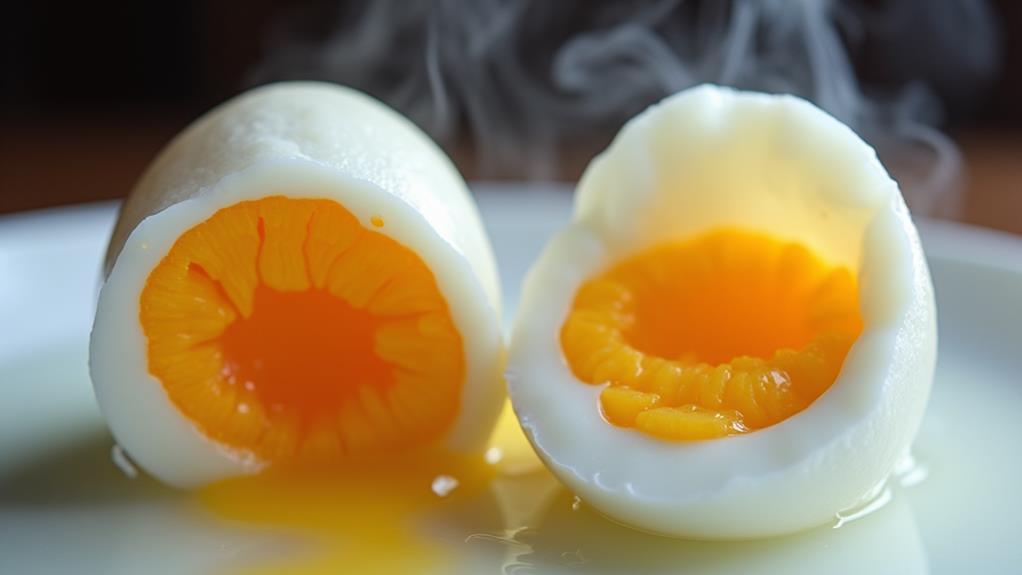
The texture and flavor profiles of boiled and poached foods differ significantly. When you're boiling food, you'll notice a firmer texture and more intense flavors, as the high heat breaks down cellular structures quickly.
Poaching, on the other hand, results in a more delicate texture and subtle taste, preserving the food's natural essence. These texture variations and flavor enhancement techniques can revolutionize your culinary creations.
To understand the impact of these cooking methods, consider the following:
- Boiling creates a uniform texture throughout the food, while poaching maintains a gradient of tenderness.
- Poached foods retain more moisture, resulting in a succulent mouthfeel.
- Boiling can intensify flavors by concentrating them, whereas poaching gently infuses the food with the cooking liquid's essence.
- The rapid boiling process can toughen proteins, while gentle poaching keeps them tender and silky.
Food Safety Considerations
When considering food safety, you'll find that both boiling and poaching offer distinct advantages.
With boiling, you're ensuring that harmful bacteria are destroyed due to the high temperatures, while poaching allows for more precise temperature control, which is crucial for certain delicate foods.
Regardless of the method you choose, it's essential to practice proper food handling techniques, such as using separate utensils for raw and cooked foods, to minimize the risk of cross-contamination and ensure safe storage and reheating of leftovers.
Temperature Control Importance
Maintaining proper temperature control is crucial for food safety when boiling or poaching. Both methods require precise cooking temperatures to ensure harmful bacteria are eliminated and nutrients are preserved.
You'll need to master temperature ranges and cooking precision to achieve optimal results.
To ensure food safety and quality, follow these key steps:
- Use a reliable food thermometer to monitor internal temperatures.
- Bring water to a full boil (212°F/100°C) for boiling, or maintain a gentle simmer (160-180°F/71-82°C) for poaching.
- Cook foods to their recommended safe internal temperatures.
- Cool cooked foods quickly to prevent bacterial growth.
Cross-Contamination Risk Reduction
Cooks must be vigilant about cross-contamination risks when boiling or poaching foods. Both methods offer unique advantages in reducing these risks, but you'll need to implement proper techniques to maximize safety.
When boiling, the high temperature effectively kills most harmful bacteria, making it an excellent choice for potentially contaminated ingredients. However, you should still be mindful of cross contamination sources, such as utensils or cutting boards used for raw meats.
Poaching, while gentler, can also minimize contamination risks when done correctly. You'll want to maintain a consistent temperature throughout the process, ensuring that harmful microorganisms are eliminated.
To enhance contamination prevention, consider using separate pots and utensils for different food types. This innovative approach can significantly reduce the chance of transferring pathogens between ingredients.
For both methods, it's crucial to clean and sanitize all surfaces and tools before and after use. You can further minimize risks by using dedicated cutting boards for raw meats and vegetables.
Storage and Reheating
Proper storage and reheating practices are crucial for maintaining food safety after boiling or poaching. When it comes to storage containers, opt for airtight, BPA-free options that can withstand temperature changes.
Glass or high-quality plastic containers work well for storing your boiled or poached foods in the refrigerator or freezer.
When it's time to reheat, you've got several methods at your disposal. Here are four innovative approaches to consider:
- Steam reheating: Place food in a steamer basket over simmering water for gentle, even heating.
- Sous vide revival: Seal leftovers in a vacuum-sealed bag and reheat in a temperature-controlled water bath.
- Microwave with moisture: Add a splash of water and cover the dish to prevent drying out.
- Oven refreshing: Use low heat and cover the dish with foil to retain moisture.
Time and Energy Efficiency
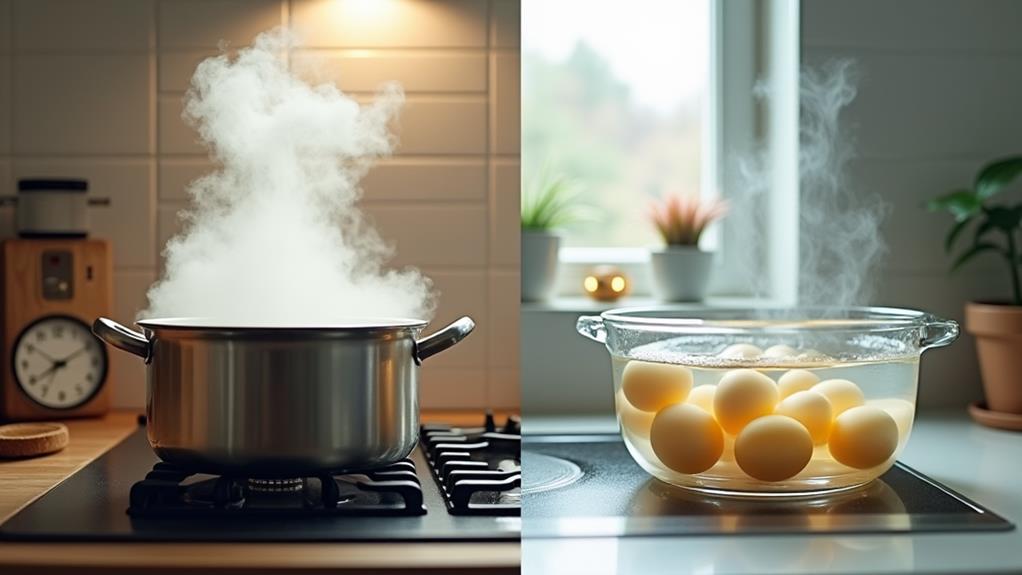
Two key factors to consider when choosing between boiling and poaching are time and energy efficiency. When you're juggling a busy schedule, effective time management in the kitchen becomes crucial.
Boiling generally requires more time to heat the water to its boiling point, while poaching can be quicker as it uses lower temperatures. However, boiling can cook food faster once the water reaches its boiling point, especially for larger quantities.
In terms of energy conservation, poaching often comes out on top. It uses less heat, which translates to lower energy consumption and potentially reduced utility bills.
Boiling, while more energy-intensive, can be more efficient when cooking multiple items simultaneously. To maximize efficiency with either method, consider using a lid to trap heat and reduce cooking time.
For poaching, you can also use the residual heat by turning off the stove near the end of cooking time, letting the food finish in the hot liquid. By understanding these time and energy dynamics, you'll be better equipped to choose the method that best aligns with your cooking goals and environmental considerations.
Versatility in Meal Preparation
Exploring the versatility of boiling and poaching reveals their unique strengths in meal preparation. These cooking methods offer you different opportunities to showcase your culinary creativity and expand your meal variety.
While boiling is ideal for hearty dishes, such as Slow Cooker Chili Con Carne, poaching excels in delicate preparations.
Consider these innovative applications for boiling and poaching:
- Boil robust vegetables like potatoes or carrots, then mash or purée them for creative side dishes.
- Poach fruits in flavored syrups for elegant desserts or breakfast toppings.
- Use boiling water to create quick, flavorful broths for soups and stews.
- Experiment with poaching eggs in various liquids, like tomato sauce or wine, for unique breakfast options.
You'll find that boiling is perfect for pasta, grains, and tough cuts of meat, allowing you to create a wide range of dishes from different cuisines.
Poaching, on the other hand, offers a gentler approach, ideal for delicate proteins like fish or chicken breast.
Temperature Control Techniques
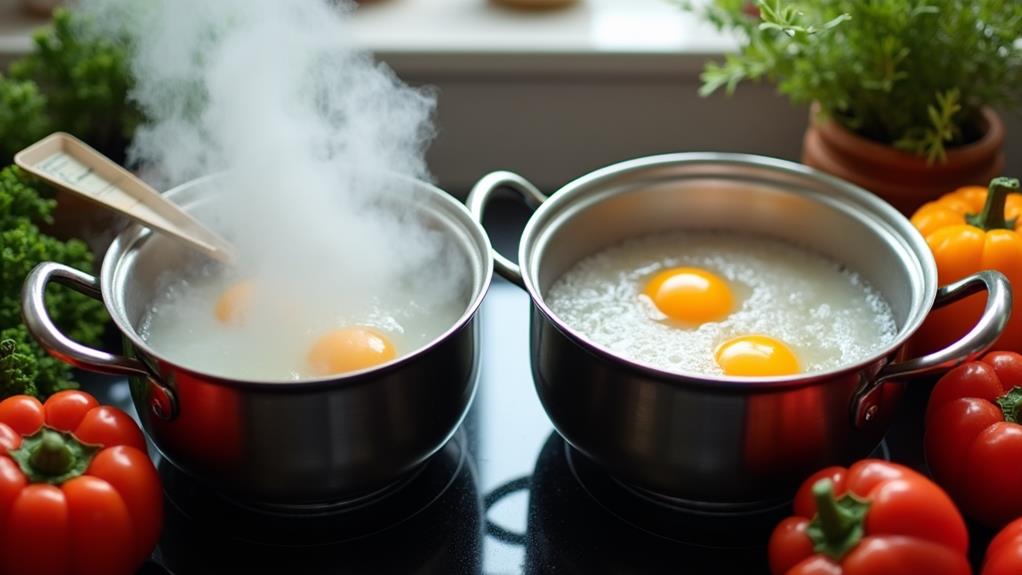
Temperature control stands at the heart of successful boiling and poaching. When you're aiming for culinary perfection, mastering these techniques is crucial.
For boiling, you'll want to bring your water to a rolling boil, typically around 212°F (100°C) at sea level. This high temperature is ideal for cooking pasta, blanching vegetables, or preparing hearty stews.
Poaching, on the other hand, requires a gentler approach. You'll need to maintain a lower temperature, usually between 160°F and 180°F (71°C to 82°C). This method is perfect for delicate foods like eggs, fish, or fruits.
To achieve precise control, consider using sous vide techniques, which involve sealing food in airtight bags and cooking in temperature-controlled water baths.
For both methods, don't overlook the power of steam cooking. It's an innovative way to retain nutrients and flavor while maintaining optimal temperature control.
By using a steamer basket or a dedicated steam oven, you can cook foods at temperatures similar to poaching but with the added benefit of steam's moisture-preserving properties.
Experiment with these techniques to elevate your cooking game and unlock new flavors and textures in your dishes.
Health Benefits Overview
Delving into the health benefits of boiling and poaching reveals distinct advantages for each method.
You'll find that both techniques offer unique ways to prepare nutritious meals while preserving essential nutrients.
Let's explore the key health benefits of these cooking methods:
- Nutrient retention: Boiling and poaching help retain water-soluble vitamins and minerals, ensuring you get the most nutritional value from your food.
- Low-fat cooking: Both methods require minimal to no added fats, making them excellent choices for calorie-conscious individuals.
- Gentle preparation: Poaching, in particular, uses lower temperatures, which can help preserve delicate proteins and reduce the formation of harmful compounds.
- Versatility: These techniques can be applied to a wide range of ingredients, allowing you to create diverse, healthy meals.
When comparing the calorie content and fat content of boiled and poached foods, you'll notice they're often similar.
However, poaching may have a slight edge in preserving flavor and texture.
By mastering these cooking methods, you're embracing innovative ways to prepare healthier meals without sacrificing taste or nutritional value.
Experiment with different ingredients and flavors to discover new, exciting dishes that align with your health goals.
Choosing the Right Method
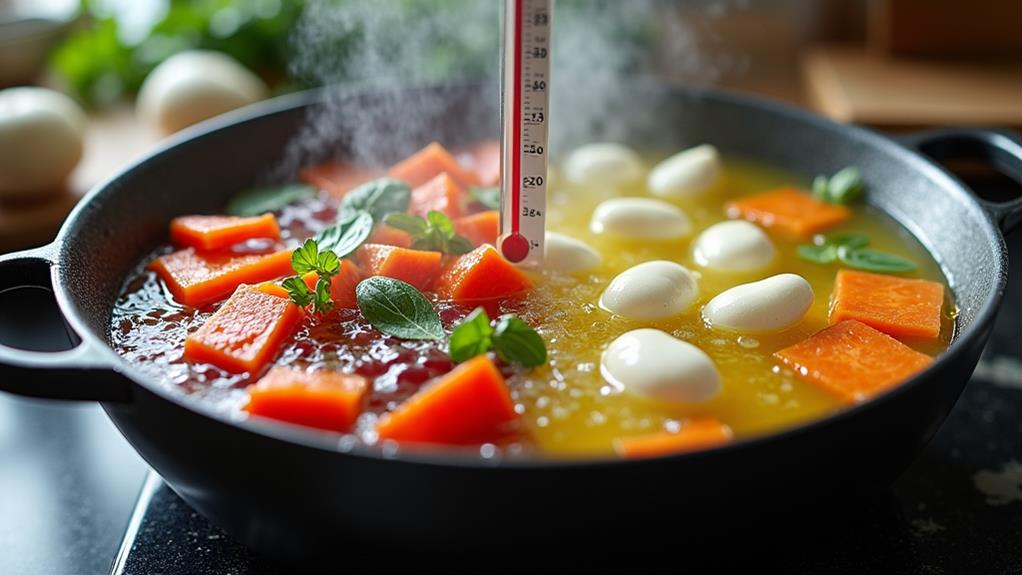
When it comes to choosing between boiling and poaching, you'll need to consider several factors. Your cooking preferences and ingredient selection play crucial roles in determining the best method for your culinary endeavors.
If you're looking to preserve the delicate flavors and textures of foods like eggs, fish, or tender meats, poaching is your go-to technique. It's gentler and allows for better control over the cooking process, resulting in moist, tender dishes.
On the other hand, boiling is ideal for heartier ingredients that can withstand higher temperatures, such as root vegetables, pasta, or tougher cuts of meat. It's also more efficient for cooking larger quantities and reducing cooking times.
Consider the nutritional aspects as well; poaching tends to retain more nutrients due to its lower temperature, while boiling may cause some nutrient loss but can be beneficial for certain foods.
Experiment with both methods to discover which suits your cooking style and dietary goals best.
Frequently Asked Questions
Can Boiling or Poaching Affect the Digestibility of Certain Foods?
You'll find that both boiling and poaching can impact digestibility effects. These methods often enhance nutrient retention and make certain foods easier to digest. Experiment with different cooking times to optimize the digestibility of your meals.
Are There Any Cultural Preferences for Boiling Versus Poaching in Different Cuisines?
You'll find cultural traditions and regional variations heavily influence cooking techniques worldwide. Poaching's delicate flavor profiles shine in French cuisine, while boiling's robust approach suits Asian culinary histories. Ingredient choices often dictate which method you'll use in innovative cooking.
How Do Boiling and Poaching Impact the Visual Appeal of Food?
Avast, ye culinary innovators! You'll notice boiling can dull colors, while poaching often preserves vibrant hues. Boiling's vigorous bubbles may roughen textures, but poaching's gentle approach maintains smooth surfaces. Both methods offer unique texture contrasts for your avant-garde dishes.
Can Boiling or Poaching Alter the Glycemic Index of Carbohydrate-Rich Foods?
You'll find that both boiling and poaching can impact the glycemic index of carb-rich foods. They'll alter the carbohydrate structure, potentially affecting your glycemic response. Innovate your cooking methods to optimize nutritional benefits and control blood sugar levels.
Are There Environmental Considerations When Choosing Between Boiling and Poaching Methods?
Dive into the eco-friendly cooking pool! You'll find poaching's gentle simmer uses less water and energy than boiling's rolling bubbles. Consider your environmental footprint by opting for poaching when possible. It's a smart, innovative choice for conscious cooks.
Final Thoughts
As you've journeyed through this culinary odyssey, you've uncovered the hidden depths of boiling and poaching. Like Odysseus choosing between Scylla and Charybdis, you'll now navigate your kitchen with newfound wisdom. Remember, there's no one-size-fits-all approach; each method has its merits. Consider your ingredients, desired outcome, and health goals when deciding. Whether you're simmering a hearty stew or delicately poaching an egg, you're now equipped to make informed choices in your culinary adventures.

